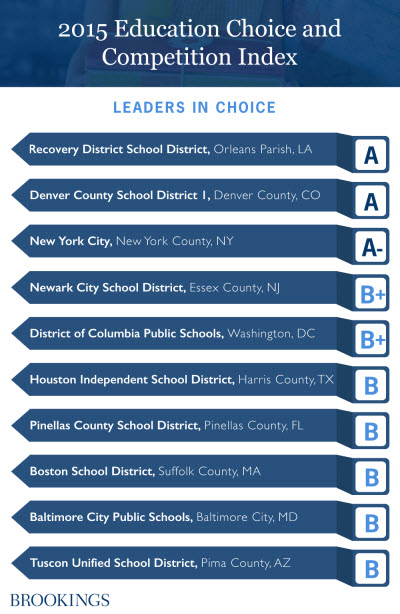All parents want what’s best for their children, and when it comes to selecting the best school, a growing number of families now have the ability to choose from multiple public schools.
Fifty-five percent of the nation’s largest school districts allow parents to choose what school their child attends, compared to only one-quarter 15 years ago. However, the degree and the ease of choice can vary drastically among districts that offer it. And in many areas, families are still only able to send their children to the school zoned for their neighborhood.
For the past five years, Economics Studies Senior Fellow Russ Whitehurst and his Brookings team have measured these and other school competition trends in the annual Education Choice and Competition Index, a report that ranks the prevalence and quality of choice offered to families by the nation’s largest school districts.
The 2015 Index offers new insight into how districts are—and aren’t—making it easy for parents to navigate the system, and whether their efforts are actually resulting in greater access to quality schools.
Here are the top 10 districts in the U.S. for school choice:

Each year, the index looks to answer a few important questions about school districts:
- Do parents have a wide variety of schools to pick from, including public, private, charter, magnet, and virtual schools?
- How easy and fair is the process by which parents express their choices and children are assigned to schools?
- Are there resources available to fund the extra costs that are associated with school choice, particularly transportation?
- Does the school district foster a competitive environment in which funds follow students to their school of choice and underperforming schools are closed, in order to maximize every family’s access to a quality education?
The New Orleans Recovery District and Denver public schools topped this year’s list. These and other top-rated school districts offer a generous “menu” of schools for families to pick from, make it easy for parents to select the school they believe is best for their child by providing good information on individual school performance, use computerized choice systems that are fair to all, and have systems in place to ensure that popular schools prosper.
In Denver, the highest-scoring large district on the list, parents have the ability to go online and compare different schools side-by-side before selecting the one that best fits their preferences, the district reserves seats in each school for choice throughout the school year, and yellow buses provide transportation to schools of choice. In the New Orleans Recovery District and Denver, parents express through a single application their preferences for all public schools of interest to them, including charter schools, and a computer algorithm assures that the resulting school assignments maximize the chance that they get their top pick. In the New Orleans Recovery District, parents can select any school regardless of its distance from their home, knowing that their child can access public transportation or school-provided transportation at no additional cost. In districts like these, argues report author Whitehurst, strong choice systems help break down the historically strong connections between where people live and public school quality that prevent lower-income or minority families from getting a top-notch education.
At the bottom of the list are districts that don’t give parents much—if any—ability to choose a school. This is the case in Alpine, Utah, the lowest-scoring district on the list, where children are assigned to schools based entirely on their residence and where there is scarce information on how other schools in the district are performing. In districts without school choice, the only part parents can play in determining where their child goes to school in the public system is by choosing where to buy or rent a home, which Whitehurst argues unfairly ties the quality of children’s public education to family income.
To see how all 112 school districts measure up—and to learn which have moved up or down over the years—read the full report and explore the interactive here.
The Brookings Institution is committed to quality, independence, and impact.
We are supported by a diverse array of funders. In line with our values and policies, each Brookings publication represents the sole views of its author(s).




Commentary
Can you choose where your child goes to school? How U.S. school districts stack up
March 1, 2016